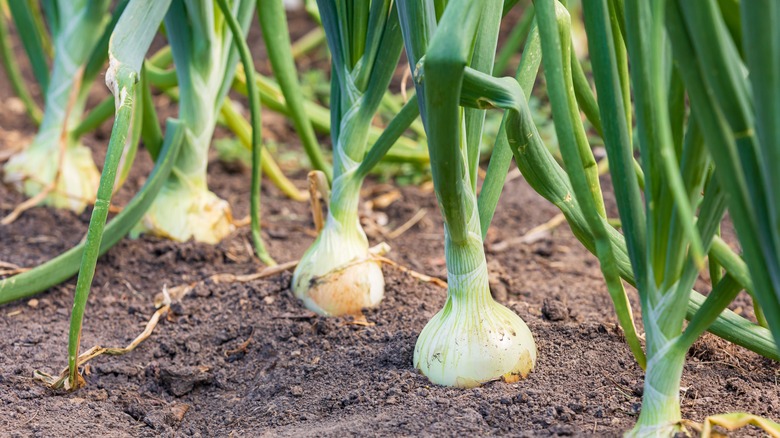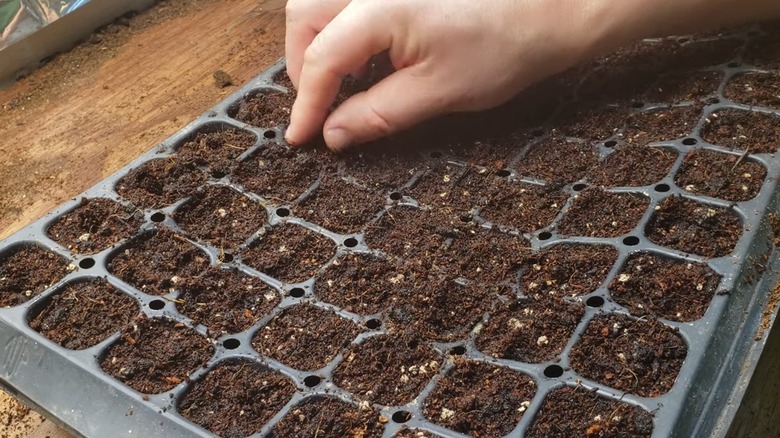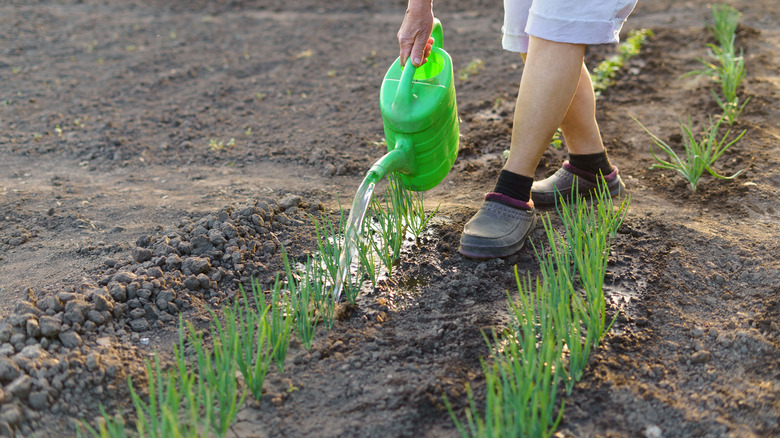Here's How Long It Might Take To Grow Onions From Seed & Tips For Success
Any discerning gastronome worth their layers can tell you that freshly harvested, homegrown onions (Allium cepa) are unparalleled in flavor and texture. But growing these alliums from seeds is uncharted territory for most vegetable patch owners. That's because alternative propagation methods involving sets (small onion bulbs) and transplants are much simpler, shortening the garden-to-saute pan journey. Indeed, set-grown alliums are ready to grace your French onion soup in around 80 days. In contrast, the onions grown from seed usually take nearly 100 days to mature fully, although that depends on the variety at hand. Cornell University has a helpful guide that maps out the days to maturity for popular onion varieties.
That being said, there are marked advantages to starting onions with seeds. They're easy on the pocket — though with extended maturity dates to match. Also, they're less likely to bolt vis-a-vis transplants. Most of all, seeds offer tons of variety in sharp contrast to the limited commercial set and transplant offerings. However, you must exercise caution before settling on a varietal onion, as it must be right for your location. Depending on the amount of sunlight necessary to coax seeds into growing bulbs, onions are classified into short-, intermediate-, and long-day types. Southerners must plant short-day onions while those in the north and central latitudes must defer to intermediate and/or long-day varieties. These can be filtered based on color (white, yellow, or red), usage (immediate or storage), flavor (sweet or spicy), and disease resistance.
Growing onions with seeds
The best time to sow most onion varieties is spring after the ground thaws, although short-day types grow better in the fall. Growing fresh onions from seed should look like this: bury them ½ to ¾ inch deep into the soil, 2 inches apart. Ensure the planted rows are at least 1 foot apart and wait for them to sprout in a week or so. You can also pop the seeds in raised beds so long they measure 4 and 20 inches on top and across. To reduce resource competition, thin out the seedlings after they reach 4 inches in height, based on the cultivars' mature size. Most bulbs are comfortable at a distance of 4 inches but bigger-sized onions may need 8-inch wide spacing. The pulled seedlings can be used as scallions.
But if you want a head start, start the seeds indoors in 6-inch pots about 10 weeks before the dirt is expected to make way for the planting season in late winter. Fill the pots to the brim with a commercial or DIY seed-starting mix and entomb the seeds 3⁄4 inch deep. Water and maintain the heat mats around 75 degrees Fahrenheit. Two to three months later, shorten the seedlings to 4 inches and shear their roots down to 1⁄2 inch. In case the sprouts turn loopy, snip them in the middle. Afterward, place the transplants 2 inches deep into the patch.
Care tips for a bountiful onion harvest
Onions are sun lovers with long- and short-day varieties demanding 14 and 10 hours a day, respectively. However, avoid this crucial mistake when growing onion seedlings: exposing them to grow lights or sun for a similar duration, as it may induce bolting. Restrict their exposure to below 10 (short-day) and 12 hours (long-day) inside. As onions need organic matter and good drainage, remember to enrich the soil with aged manure or compost, especially if it has significant clay content. While onion plants tolerate sandy substrates, high acidity or salinity levels are a no-no, so ensure the pH levels don't fall below 6 — a soil test will help. You'll also need to side-dress your seedlings (multiple times) with nitrogen-heavy fertilizers mid-season (early summer or late spring) to encourage growth. But resist any further applications a month before harvesting, as it might delay maturity while leaving the bulbs soft and unamenable to curing for storage.
Since onions are shallow-rooted, they must be watered weekly with 1 inch of water to keep the soil moist. The unspoken rule is that the greater the amount of water applied to the juveniles, the bigger the mature bulbs. But go hose-free when the bulbs are nearing maturity or if it rains. Don't forget to hand weed or cultivate the beds, as onion plants are inept at shading out the unruly growth with their foliage. Mulching with herbicide-free repurposed lawn clippings for a healthier garden should aid weed suppression.


